Classification and distribution of South Atlantic Recent polycystine Radiolaria
Plain Language Abstract
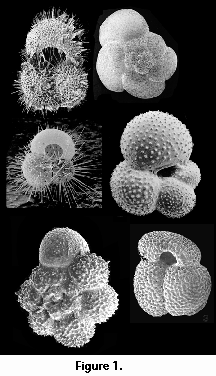 Radiolarians are exclusively marine, planktonic (living in suspension in the water column), single-celled organisms (protists). They normally dwell in open-ocean waters, and are absent or rare near the coast. As most other closely related planktonic protists, like the Foraminifera (Figure 1) and the Acantharia (Figure 2), radiolarians are omnivorous particle feeders which catch their prey (small algal cells, other protists, small crustaceans, etc.) with the aid of their sticky cytoplasmic strands protruding from the cell body, the pseudopodia (axopodia - thicker, more rigid and provided with a central shaft, and the filopodia - thinner and more flexible than the former, article: Figure 1A). In addition, many species host living algal cells in their cytoplasm (Figure 3); the animal benefits from the organic matter produced photosynthetically by the symbiont alga, while the alga takes advantage of the various substances which the animal produces in its metabolism and would otherwise have to discard in the water. Most radiolarian species are solitary, each individual being represented by a single cell, yet a few species form colonies in which many cells, enclosed in a gelatinous cylindrical or otherwise shaped sheath (article: Figs. 1C, 15.6, 15.7, 15.8, 15.11, 15.12), are connected with each other by cytoplasmic strands. Radiolarians (and the closely related Acantharia, Figure 2) differ from other protists in having their cytoplasm divided into 2 regions by a proteic perforated membrane - the central capsule membrane.
Radiolarians are exclusively marine, planktonic (living in suspension in the water column), single-celled organisms (protists). They normally dwell in open-ocean waters, and are absent or rare near the coast. As most other closely related planktonic protists, like the Foraminifera (Figure 1) and the Acantharia (Figure 2), radiolarians are omnivorous particle feeders which catch their prey (small algal cells, other protists, small crustaceans, etc.) with the aid of their sticky cytoplasmic strands protruding from the cell body, the pseudopodia (axopodia - thicker, more rigid and provided with a central shaft, and the filopodia - thinner and more flexible than the former, article: Figure 1A). In addition, many species host living algal cells in their cytoplasm (Figure 3); the animal benefits from the organic matter produced photosynthetically by the symbiont alga, while the alga takes advantage of the various substances which the animal produces in its metabolism and would otherwise have to discard in the water. Most radiolarian species are solitary, each individual being represented by a single cell, yet a few species form colonies in which many cells, enclosed in a gelatinous cylindrical or otherwise shaped sheath (article: Figs. 1C, 15.6, 15.7, 15.8, 15.11, 15.12), are connected with each other by cytoplasmic strands. Radiolarians (and the closely related Acantharia, Figure 2) differ from other protists in having their cytoplasm divided into 2 regions by a proteic perforated membrane - the central capsule membrane.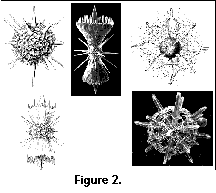 This membrane separates the inner part of the cytoplasm, known as endoplasm, which contains the nucleus or nuclei of the cell, from the outer part, the ectoplasm (article: Figure 1A). With but a few exceptions, the cytoplasm encloses a shell or skeleton made up of silica. Radiolarian skeletons are extremely diverse, and they are the key feature on the basis of which this subclass is classified into smaller units (classes, superorders, orders, families, genera and species, Figure 4). In the simplest case the skeleton is represented by several isolated straight or branching spines loosely distributed in the cytoplasm (article: Figure 15.4).
This membrane separates the inner part of the cytoplasm, known as endoplasm, which contains the nucleus or nuclei of the cell, from the outer part, the ectoplasm (article: Figure 1A). With but a few exceptions, the cytoplasm encloses a shell or skeleton made up of silica. Radiolarian skeletons are extremely diverse, and they are the key feature on the basis of which this subclass is classified into smaller units (classes, superorders, orders, families, genera and species, Figure 4). In the simplest case the skeleton is represented by several isolated straight or branching spines loosely distributed in the cytoplasm (article: Figure 15.4). 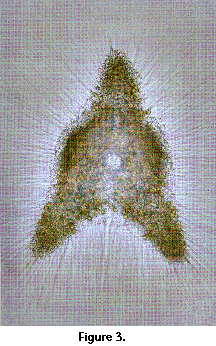 In most species, however, more or less elaborate structures develop, like one or more concentric spherical shells with protruding spines or tubes (article: Figs. 15.20, 15.26, 15.40, 15.47, 15.48), lentil-like disks (article: Figs. 15.62, 15.63), three-armed, propeller-like, structures (article: Figs. 15.70, 15.71), spiral meshworks (article: Figs. 15.86, 15.87, 15.88), elongated constructions with one or several inflated sections or segments (article: Figs. 15.136, 15.137, 15.141, 15.163), widely open funnel-like shells resembling a Chinese peasant hat (article: Figure 15.148), etc. In all cases, the skeleton is composed of siliceous bars or rods which merge with each other leaving empty spaces between them - the pores (article: Figure 2F). A brief review of polycystine biology, ecology, feeding and reproduction is presented in this paper.
In most species, however, more or less elaborate structures develop, like one or more concentric spherical shells with protruding spines or tubes (article: Figs. 15.20, 15.26, 15.40, 15.47, 15.48), lentil-like disks (article: Figs. 15.62, 15.63), three-armed, propeller-like, structures (article: Figs. 15.70, 15.71), spiral meshworks (article: Figs. 15.86, 15.87, 15.88), elongated constructions with one or several inflated sections or segments (article: Figs. 15.136, 15.137, 15.141, 15.163), widely open funnel-like shells resembling a Chinese peasant hat (article: Figure 15.148), etc. In all cases, the skeleton is composed of siliceous bars or rods which merge with each other leaving empty spaces between them - the pores (article: Figure 2F). A brief review of polycystine biology, ecology, feeding and reproduction is presented in this paper.
Radiolarians inhabit all major oceans and all depths of the water column, down to over 8,000-10,000 m. Different species are usually more or less loosely associated with different depth ranges, yet the greatest majority prefer the uppermost layers, with highest cell densities and specific diversities occurring between 5-10 and approximately 100-150 m (article: Figure 12A, B). This work summarizes current knowledge on the geographic and vertical distribution of the 164 living polycystine morphotypes (species-groups, species, and subspecific categories) so far recorded or presumed to occur in the South Atlantic Ocean (0 to 60°S, from the South American coasts to the coasts of Africa). However, because the area concerned covers from equatorial to Antarctic waters, and since polycystine radiolarians tend to inhabit all oceans within the same climatic zone, the review covers most of the common species worldwide.
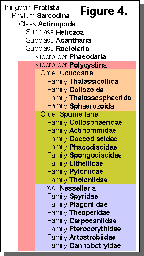 Two major groups, or superorders, are recognized within the Radiolaria: the Polycystina and the Phaeodaria (Figure 4). Among other traits, the two differ in the chemical composition of their skeletons: while in the Polycystina these are made up of amorphous silica (basically, the composition of sand grains), in the Phaeodaria (Figure 5) the silica is supported by an organic matrix. Representatives of both groups sink to the ocean floor upon death, but differences in the composition of their skeletons are responsible for the fact that while polycystine skeletons can withstand dissolution during and after descent, phaeodarian shells usually dissolve even before reaching the bottom. Thus, large areas of the ocean floor are covered with a thick layer of polycystine shells, also known as radiolarian ooze (Figure 6). The Superorder Polycystina comprises 3 orders and 20 families (Figure 4). This paper contains descriptions of these taxonomic categories, as well as brief diagnoses and illustrations of the 164 known South Atlantic morphotypes. A profusely illustrated glossary aimed at the less experienced student defines the terms and morphological details useful for diagnostic purposes.
Two major groups, or superorders, are recognized within the Radiolaria: the Polycystina and the Phaeodaria (Figure 4). Among other traits, the two differ in the chemical composition of their skeletons: while in the Polycystina these are made up of amorphous silica (basically, the composition of sand grains), in the Phaeodaria (Figure 5) the silica is supported by an organic matrix. Representatives of both groups sink to the ocean floor upon death, but differences in the composition of their skeletons are responsible for the fact that while polycystine skeletons can withstand dissolution during and after descent, phaeodarian shells usually dissolve even before reaching the bottom. Thus, large areas of the ocean floor are covered with a thick layer of polycystine shells, also known as radiolarian ooze (Figure 6). The Superorder Polycystina comprises 3 orders and 20 families (Figure 4). This paper contains descriptions of these taxonomic categories, as well as brief diagnoses and illustrations of the 164 known South Atlantic morphotypes. A profusely illustrated glossary aimed at the less experienced student defines the terms and morphological details useful for diagnostic purposes.
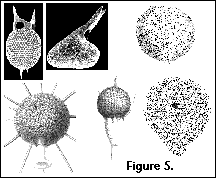 The fact that polycystine radiolarians are preserved in the sediments after death has been instrumental in their application to paleontological studies. The earliest records of their shells in fossiliferous deposits date back to the Cambrian (1,000 million years before the present). Radiolarian remains in the sediments allow a variety of studies, including determinations of the age of the sediments that contain them, analyses of the spatial relationships between sedimentary layers (of particular importance for the oil industry), studies of the geologic evolution of the continental land masses and ocean basins, etc. Investigation of the changes in the morphology of radiolarian skeletons through time yields first hand information on the evolution of the group, and on the rates and modes of species formation and extinction (Figure 7). During the last decades particular attention has been dedicated to the analysis of climatic changes in various geographic areas.
The fact that polycystine radiolarians are preserved in the sediments after death has been instrumental in their application to paleontological studies. The earliest records of their shells in fossiliferous deposits date back to the Cambrian (1,000 million years before the present). Radiolarian remains in the sediments allow a variety of studies, including determinations of the age of the sediments that contain them, analyses of the spatial relationships between sedimentary layers (of particular importance for the oil industry), studies of the geologic evolution of the continental land masses and ocean basins, etc. Investigation of the changes in the morphology of radiolarian skeletons through time yields first hand information on the evolution of the group, and on the rates and modes of species formation and extinction (Figure 7). During the last decades particular attention has been dedicated to the analysis of climatic changes in various geographic areas. 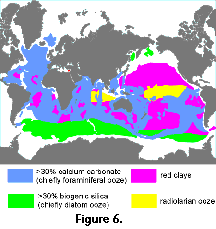 These studies have been partly fueled by concerns associated with global warming and the greenhouse effect. Because the observed changes in the climatic patterns of the last couple of centuries are most probably associated both with man-induced modifications of the atmosphere, and with "natural" climatic cycles (chiefly related with changes in the parameters which define the earth’s rotation around the sun), understanding of these cycles in the past centuries to millennia, the object of paleoecology and paleoclimatology, is crucial for interpreting today's climatic changes and forecasting future trends. Polycystine radiolarians are among the very few tools available for investigating these changes in the oceanic realm. The techniques in question are based on comparisons of the radiolarian assemblages in the water column and/or in the topmost sedimentary layer (which are assumed to represent more or less faithfully the living populations), with those retrieved from sediments buried deeper under the sea floor (and therefore older in age). Each assemblage is characterized by a particular combination of species in more or less defined proportions. Because radiolarians (as most other organisms) are sensitive to environmental conditions, different species and species proportions in the assemblages are indicative of different living conditions, in particular water temperature and productivity. Thus, qualitative and quantitative differences between a Recent assemblage and one produced, for example, 50 years ago, can offer valuable information on dissimilarities in the prevailing environmental conditions that engendered the observed changes in the radiolarian assemblages.
These studies have been partly fueled by concerns associated with global warming and the greenhouse effect. Because the observed changes in the climatic patterns of the last couple of centuries are most probably associated both with man-induced modifications of the atmosphere, and with "natural" climatic cycles (chiefly related with changes in the parameters which define the earth’s rotation around the sun), understanding of these cycles in the past centuries to millennia, the object of paleoecology and paleoclimatology, is crucial for interpreting today's climatic changes and forecasting future trends. Polycystine radiolarians are among the very few tools available for investigating these changes in the oceanic realm. The techniques in question are based on comparisons of the radiolarian assemblages in the water column and/or in the topmost sedimentary layer (which are assumed to represent more or less faithfully the living populations), with those retrieved from sediments buried deeper under the sea floor (and therefore older in age). Each assemblage is characterized by a particular combination of species in more or less defined proportions. Because radiolarians (as most other organisms) are sensitive to environmental conditions, different species and species proportions in the assemblages are indicative of different living conditions, in particular water temperature and productivity. Thus, qualitative and quantitative differences between a Recent assemblage and one produced, for example, 50 years ago, can offer valuable information on dissimilarities in the prevailing environmental conditions that engendered the observed changes in the radiolarian assemblages.
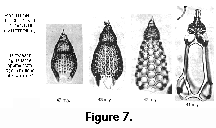 These techniques, also used widely with several other marine shelled organisms, rely heavily on our capacity to differentiate between species, as well as on adequate knowledge of their environmental preferences. Although the examples above may give the impression that different radiolarian species differ widely in their morphology, in reality there are at least as many "confusing" species as clearly identifiable ones. In his 1887 cornerstone monograph on these organisms, the German naturalist Ernst Haeckel described some 3700 polycystine species; today it is widely recognized that a very significant proportion of these "species" are nothing but developmental stages, poorly preserved (partly dissolved) organisms, slightly different morphotypes of the same species, etc. Unfortunately, misidentifications and establishment of spurious species (that is, "species" which are synonymous with others, already described previously) is a common phenomenon in radiolarian literature. This is partly explained by the rather intricate morphology of many radiolarians, requiring careful observation and very good knowledge of the group. In addition, different developmental stages of the same organism often differ in features that are traditionally considered as specific or even generic traits. Thus, a species whose adults possess 5 concentric spherical shells starts as a single tiny sphere with large pores, then the second sphere is formed, then the third, and so on (article: Figure 14). In Haeckel’s classification scheme, all these growth stages would qualify as different species. Furthermore, when this shell drops to the ocean floor and starts dissolving slowly, the innermost spheres, with thinner walls, disappear first, thus yielding a new set of different "species" (Figure 8).
These techniques, also used widely with several other marine shelled organisms, rely heavily on our capacity to differentiate between species, as well as on adequate knowledge of their environmental preferences. Although the examples above may give the impression that different radiolarian species differ widely in their morphology, in reality there are at least as many "confusing" species as clearly identifiable ones. In his 1887 cornerstone monograph on these organisms, the German naturalist Ernst Haeckel described some 3700 polycystine species; today it is widely recognized that a very significant proportion of these "species" are nothing but developmental stages, poorly preserved (partly dissolved) organisms, slightly different morphotypes of the same species, etc. Unfortunately, misidentifications and establishment of spurious species (that is, "species" which are synonymous with others, already described previously) is a common phenomenon in radiolarian literature. This is partly explained by the rather intricate morphology of many radiolarians, requiring careful observation and very good knowledge of the group. In addition, different developmental stages of the same organism often differ in features that are traditionally considered as specific or even generic traits. Thus, a species whose adults possess 5 concentric spherical shells starts as a single tiny sphere with large pores, then the second sphere is formed, then the third, and so on (article: Figure 14). In Haeckel’s classification scheme, all these growth stages would qualify as different species. Furthermore, when this shell drops to the ocean floor and starts dissolving slowly, the innermost spheres, with thinner walls, disappear first, thus yielding a new set of different "species" (Figure 8).
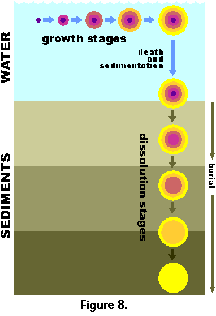 As indicated above, species-specific distributional data are of primary importance for using the polycystines for paleoclimatic analyses. These data are derived from (1) collections of living radiolarians at various depths in the plankton; (2) collections of radiolarian shells settling towards the sea floor by means of sediment traps - variously shaped containers which intercept the rain of sedimenting particles from the upper water layers at depth; and (3) collections of samples of surface and subsurface sediments, where radiolarian shells accumulate after death. Information conveyed by these different sources may differ significantly. Thus, seasonal cycles and vertical distribution patters, among others, may strongly bias interpretations based on planktonic samples. Assemblages recovered in sediment traps and bottom sediments, in turn, may differ from the corresponding planktonic populations due to destruction of the shells by grazers, horizontal displacement of the settling shells on their way to the sea floor by intermediate and deep currents, partial or total dissolution of some fragile species during and after sedimentation, etc. (article: Figure 6). The mechanisms involved and the concomitant potential biases for paleoclimatic interpretations are discussed in detail in the article.
As indicated above, species-specific distributional data are of primary importance for using the polycystines for paleoclimatic analyses. These data are derived from (1) collections of living radiolarians at various depths in the plankton; (2) collections of radiolarian shells settling towards the sea floor by means of sediment traps - variously shaped containers which intercept the rain of sedimenting particles from the upper water layers at depth; and (3) collections of samples of surface and subsurface sediments, where radiolarian shells accumulate after death. Information conveyed by these different sources may differ significantly. Thus, seasonal cycles and vertical distribution patters, among others, may strongly bias interpretations based on planktonic samples. Assemblages recovered in sediment traps and bottom sediments, in turn, may differ from the corresponding planktonic populations due to destruction of the shells by grazers, horizontal displacement of the settling shells on their way to the sea floor by intermediate and deep currents, partial or total dissolution of some fragile species during and after sedimentation, etc. (article: Figure 6). The mechanisms involved and the concomitant potential biases for paleoclimatic interpretations are discussed in detail in the article.
Resumen en Español
CLASIFICACIÓN Y DISTRUCIÓN DE RADIOLARIA POLYCYSTINA RECIENTES DEL ATLÁNTICO SUR
Se presenta una revisión del estado actual del conocimiento acerca de la identificación y ditribución de los radiolarios Polycystina efectivamente registrados o presumiblemente presentes en el Océano Atlántico Sur (0 a 60°S, desde las costas de América del Sur hasta las costas africanas). Sin embargo, dado que el área abarcada incluye aguas ecuatoriales a antárticas, y en vista de que los radiolarios Polycystina son geográficamente (pero no ecológicamente) cosmopolitas, el trabajo cubre la mayoría de las especies comunes en el Océano Mundial. Se proveen ilustraciones, breves diagnosis, referencias bibliográficas pertinentes y datos acerca de la distribución, tanto geográfica como vertical, de 164 morfotipos (grupos de especies, especies y categorías infraespecíficas). Las secciones introductorias incluyen información sobre la anatomía, biología, ecología y reproducción. Los aspectos metodológicos se tratan en detalle, con especial énfasis en aspectos comparativos de la información ambiental y paleoambiental que ofrecen los materiales planctónicos, los de trampas de sedimentos, y las muestras de sedimentos. Se resumen los rangos distributivos verticales y geográficos conocidos o inferidos, así como la información disponible acerca de la abunbdancia absoluta de estos protistas en la columna de agua (muestras de plancton y de trampas de sedimentos), y en los sedimentos superficiales. Un glosario profusamente ilustrado de términos y estructuras específicos utilizados en la identificación de estos organismos tiene por finalidad facilitar el trabajo de los investigadores sin experiencia previa en el grupo.
Palabras clave: Radiolaria Polycystina, identificación, distribución, Reciente, plancton, revisión
Résumé en Français
LA CLASSIFICATION ET LA DISTRIBUTION DES RADIOLAIRES POLYCYSTINES RÉCENTES DE L’ATLANTIQUE AUSTRAL1
Cet article révise nos connaissances au sujet de l’identification et la distribution des radiolaires polycystines récentes trouvées ou postulées d’être dans l’Atlantique austral (de 0 à 60°S, des côtes d’Amérique du Sud jusqu’aux côtes d’Afrique). Cependant, la région s’étendant des eaux équatoriaux jusqu’à l’Antartique, et les radiolaires polycystines étant cosmopolites (selon la géographie, et non pas l’environnement), cet ouvrage inclut la majorité des espèces mondiales les plus communes. Des illustrations, de courtes diagnostiques, des références bibliographiques, et des données distributionelles (géographiques et verticales) pour 164 morphotypes polycystines (groupes des espèces, espèces, et catégories sous-espèces) sont inclus. Les remarques introductifs présentent des données générales relatifs à l’anatomie, la biologie, l’écologie, et la reproduction des polystines. Les aspects méthodologiques sont examinés en détail, appuyant des comparaisons entre les données environnementales et paléoenvironnementales des matériaux planctoniques, des échantillons des pièges sédimentaires, et des dépôts sédimentaires. Les étendues de distribution géographique et verticale reconnues ou postulées des espèces sont résumés, ainsi que les données des abondances absolues dans la colonne d’eau (plancton et échantillons des pièges sédimentaires) et dans les sédiments de la surface. Un glossaire abondamment illustré visant les étudiants débutants définit les termes et les détails morphologiques utiles aux diagnostiques.
Mots clés: Radiolaria Polycystina, identification, distribution, récent, plancton, revue
Deutsche Zusammenfassung
KLASSIFIKATION UND VERBREITUNG REZENTER POLYCYSTINER RADIOLARIEN IM SÜD-ATLANTIK
Diese Arbeit vermittelt eine Übersicht über das derzeitige Verständnis zur Identifikation und Verbreitung rezenter polycystiner Radiolarien, soweit sie im Süd-Atlantik (0-60 ° beobachtet oder vermutet wurden. Weil das Gebiet von äquatorialen bis asntarktischen Wassermassen reicht und weil polycystine Radiolarien geographisch (jedoch nicht auf die Umwelt bezogen) kosmopolitisch sind, deckt die Übersicht die meisten häufigeren Arten weltweit ab. Abbildungen, Kurzdiagnosen, Literaturhinweise und Verbreitungsdaten (geographisch und stratigraphisch) werden für 164 polycystine Morphotypen gegeben (Artgruppen, Arten, Unterarten). Eine Einführung enthält allgemeine Bemerkungen zur Anatomie, Biologie, Oekologie und Reproduktion der Radiolarien. Im Detail werden einige methodische Aspekte behandelt, besonders soweit sie sich auf vergleichende Aspekte von Umwelt- und Paläoumwelt beziehen, die aus Planktonmaterial, Sinkstofffallen und Sedimenten abgeleitet werden. Die bekannte oder vermutete geographische und stratigraphische Reichweite von Arten wird zusammengefasst, ebenso wie verfügbare Information über absolute Häufigkeiten in der Wassersäule (Plankton, Sinkstoffallen) und in Oberflächensedimenten. Ein ausführlich bebildertes Glossar für den nicht-Spezialisten definiert Begriffe und morphologische Details, die für Diagnosen Bedeutung haben.
Stichworte: Radiolaria, Polycystina, Bestimmung, Verbreitung, Rezent, Plankton, Übersicht
Italiano
CLASSIFICAZIONE E DISTRIBUZIONE DEI RADIOLARI POLICISTINI ATTUALI DELL'ATLANTICO MERIDIONALE
Questo lavoro presenta una revisione dello stato attuale delle conoscenze sull'identificazione e sulla distribuzione dei radiolari policistini effettivamente riconosciuti fino ad ora (o presumibilmente presenti)nell&#Oceano Atlantico meridionale (da 0° a 60°S, dalle coste sudamericane a quelle dell'Africa). Poichè l'area interessata va dalle acque equatoriali a quelle antartiche, e poichè i radiolari policistini sono geograficamente (anche se non ambientalmente) cosmopoliti, possiamo dire che questo lavoro si occupa della maggior parte delle specie a scala mondiale. Vengono fornite illustrazioni, brevi diagnosi e referenze bibliografiche assieme a dati di distribuzione, sia geografica che verticale, per 164 morfotipi (gruppi di specie, specie e categorie infra-specifiche). Le sezioni introduttive includono informazioni generali sull'anatomia, la biologia, l'ecologia e le modalità di riproduzione dei radiolari. Gli aspetti metodologici vengono trattati in dettaglio, con un'enfasi particolare sugli aspetti comparativi delle informazioni ambientale e paleoambientale fornite dai materiali planctonici, dalle trappole sedimentarie e dai depositi sedimentari. Vengono schematizzati gli intervalli di distribuzione geografici e verticali, conosciuti o presunti, così come le informazioni disponibili sull''abbondanza assoluta di questi protisti nella colonna d'acqua (campioni di plancton e di trappole sedimentarie) e nei sedimenti di superficie. Infine, la presenza di un glossario abbondantemente illustrato dei termini e delle strutture specifiche utilizzati nell'identificazione di questi organismi ha per finalità la facilitazione del lavoro per gli studiosi senza precedente esperienza sui radiolari.
Parole chiave: Radiolaria, Polycystina, identificazione, distribuzione, Attuale, plancton, revisione

